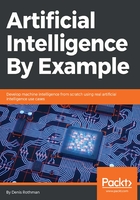
Determining what and how to measure
In Chapter 2, Think Like a Machine, the system of McCulloch-Pitts neurons generated a vector with a one-hot function in the following process.

R, the reward vector, represents the input of the reinforcement learning program and needs to be measured.
This chapter deals with an approach designed to build a reward matrix based on the company data. It relies on the data, weights, and biases provided. When deep learning forward feedback neural networks based on perception are introduced (Chapter 4, Become an Unconventional Innovator), a system cannot be content with a training set. Systems have a natural tendency to learn training sets through backpropagation. In this case, one set of company data is not enough.
In real-life company projects, a system will not be validated until tens of thousands of results have been produced. In some cases, a corporation will approve the system only after hundreds of datasets with millions of data samples have been tested to be sure that all scenarios are accurate. Each dataset represents a scenario consultants can work on with parameter scripts. The consultant introduces parameter scenarios that are tested by the system and measured. In systems with up to 200 parameters per neuron, a consultant will remain necessary for many years to come in an industrial environment. As of Chapter 4, Become an Unconventional Innovator, the system will be on its own without the help of a consultant. Even then, consultants often are needed to manage the hyperparameters. In real-life systems, with high financial stakes, quality control will always remain essential.
Measurement should thus apply to generalization more than simply applying to a single or few datasets. Otherwise, you will have a natural tendency to control the parameters and overfit your model in a too-good-to-be-true scenario.
Beyond the reward matrix, the reinforcement program in the first chapter had a learning parameter λ = 0.8, as shown in the following code source.
# Gamma : It's a form of penalty or uncertainty for learning
# If the value is 1 , the rewards would be too high.
# This way the system knows it is learning.
gamma = 0.8
The λ learning parameter in itself needs to be closely monitored because it introduces uncertainty into the system. This means that the learning process will always remain a probability, never a certainty. One might wonder why this parameter is not just taken out. Paradoxically, that will lead to even more global uncertainty. The more the λ learning parameter tends to 1, the more you risk overfitting your results. Overfitting means that you are pushing the system to think it's learning well when it isn't. It's exactly like a teacher who gives high grades to everyone in the class all the time. The teacher would be overfitting the grade-student evaluation process, and nobody would know whether the students have learned something.
The results of the reinforcement program need to be measured as they go through episodes. The range of the learning process itself must be measured. In the following code, the range is set to 50,000 to make sure the learning process reaches its goal.
for i in range(50000):
current_state = ql.random.randint(0, int(Q.shape[0]))
PossibleAction = possible_actions(current_state)
action = ActionChoice(PossibleAction)
reward(current_state,action,gamma)
All of these measurements will have a deep effect on the results obtained.